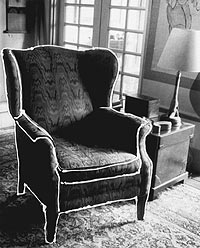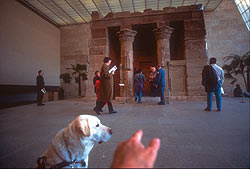Berkeleyan
In the eye of the beholder
Berkeley Art Museum and the Townsend Center take a closer look at art and visual impairment in 'Blind at the Museum' exhibit
![]()
| 02 March 2005
In conjunction with its "Blind at the Museum" exhibit, the Berkeley Art Museum (BAM) is holding a two-day conference on Friday and Saturday, March 11 and 12, to explore topics related to visual impairment, art, access, and the role of the viewer.
 In "A Chair Is Still a Chair, 2004," artist Kurt Weston used caulk to create a touchable photograph and break down barriers between art and viewers. Weston, who lost his sight due to cytomegalovirus (CMV), considers his camera a surrogate eye. |
Along with Georgina Kleege, an assistant professor of English who is legally blind, Sherwood conceived the idea of the conference, which she wanted to give "a Berkeley flair" by centering it around disability studies. Kleege, who at age 11 began grappling with the loss of her eyesight due to macular degeneration, wrote Sight Unseen, part memoir and part cultural critique of the world's stigmatization of blindness. She will be the keynote speaker on Friday, March 11, at 4 p.m.
A panel of artists featured in the exhibit - including Pedro Hidalgo, Michael Richard, Kurt Weston, Alice Wingwall, and moderator Kari Orvik from the nonprofit organization Lighthouse for the Blind - will follow at 5 p.m.
Andrew Potok, author of Ordinary Daylight: Portrait of an Artist Going Blind, will begin the Saturday, March 12, session at 10 a.m. Joseph Grigely, an artist in the exhibit who is professor of visual and critical studies at the School of the Art Institute of Chicago, will give a talk at 1:30. Panels that day will examine interventions and technologies as they relate to viewing artwork, look at the perceptual experience of unsighted people, and explore the historical and social contexts for understanding blindness. For information, visit bampfa.berkeley.edu/education/blind/index.html.
Portrait of a blind photographer
Before she began losing her eyesight late in life to retinitis pigmentosa, Alice Wingwall was a fully sighted conceptual artist and photographer. As her sight gradually diminished, Wingwall decided not to relinquish her photography. To those who ask her how she could possibly take pictures as a blind person, Wingwall responds, "Any photograph begins with an idea in the brain." Assistants help the artist keep her automatic camera pointed at the image she describes to them from her mind's eye.
 Artist Alice Wingwall, who felt a powerful bond with her first guide dog, wanted to share her passion for architecture with him. In "Hand Over Dog: Joseph at the Temple of Dendur, The Metropolitan of Museum of Art, 1995" the artist directs her beloved guide dog's attention to Egyptian gates dating back to 15 B.C.E. |

